Facts About the Spring Triangle Asterism
The Spring Triangle asterism consists of the stars Arcturus, Spica, and Regulus. Arcturus belongs in the constellation of Boötes the Herdsman. Spica is from Virgo the Maiden, while Regulus is from Leo the Lion. Let’s take a look at some quick fire facts to start things off!
- All three of the stars in the Spring Triangle have the “alpha” designation. It means that they are the brightest stars in their respective constellations.
- Arcturus (Alpha Boötis) has an apparent magnitude of -0.05, making it the fourth brightest star in our sky. The first three are Sirius, Canopus, and Alpha Centauri (Rigil Kentaurus and Toliman).
- Spica or Alpha Virginis is a magnitude 0.97 star. Apart from being the brightest star in the Virgo constellation, it is also the 16th brightest star in the night sky.
- Regulus shines with an apparent magnitude of 1.40. It is the 21st brightest star in our sky but the faintest point in the Spring Triangle asterism.
- In other sources, instead of Regulus, the third star is replaced with Denebola. It is the second-brightest star in the Leo constellation. With Denebola, the pattern becomes more of an equilateral triangle.
- The stars Arcturus and Spica of the Spring Triangle are part of the Great Diamond asterism or the Virgin’s Diamond. The other stars in this bigger asterism are Denebola and Cor Caroli. The latter is the brightest star in the constellation of Canes Venatici or the Hunting Dogs.
- At a distance of 36.7 light-years, Arcturus is the closest star to us in the Spring Triangle asterism. It is also the brightest in both the asterisms of the Spring Triangle and the Great Diamond.
- In the northern hemisphere, the Spring Triangle can be seen from around March to May. This asterism appears prominent in the night sky as the three stars forming its vertices rise due southeast.
The Spring Triangle Asterism
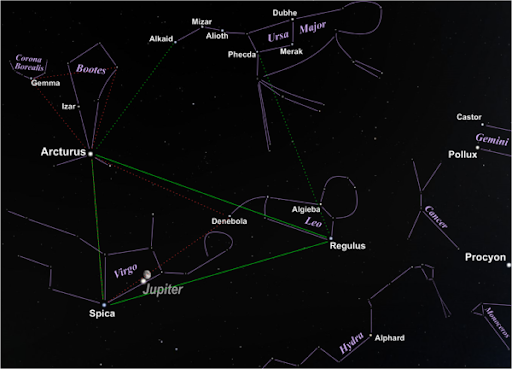
The Spring Triangle is an asterism in the northern hemisphere. It is formed by connecting the brightest stars in the constellations of Boötes the Herdsman, Virgo the Maiden, and Leo the Lion. These stars are Arcturus (Alpha Boötis), Spica (Alpha Virginis), and Regulus (α Leonis).
The term “Spring Triangle” was popularized by George Lovi of the Sky & Telescope magazine. It was inspired by the more famous Summer Triangle asterism, which is formed by the three bright stars Vega, Altair, and Deneb. In another source, the spring asterism is also called the “Virgo Triangle.”
Though the most known vertices of the Spring Triangle are Arcturus, Spica, and Regulus, the star Denebola is sometimes included in this asterism. It is the star that marks the tail of the celestial Lion. Instead of Regulus, Denebola becomes the third vertex, making the Spring Triangle more of an equilateral shape.
Two versions of the Spring Triangle, with Denebola or Regulus as the third vertex. Image via Scott Levine.
Arcturus, Spica, and Denebola are part of a bigger spring asterism called the Great Diamond. This sky pattern is also called the Diamond of Virgo or the Virgin’s Diamond. The fourth vertex of this asterism is the binary star Cor Caroli of the Canes Venatici constellation. This diamond is a bit larger than that of the Big Dipper (or Plough).
Unlike the Summer Triangle, the Milky Way is not in the background of the Spring Triangle. But with the Virgo Cluster nearby, this asterism remains a region rich in deep-sky objects.
Some of the most notable deep-sky objects in the vicinity of the Spring Triangle are the Siamese Twins, the Eyes Galaxies, the Leo Triplet, and the Boötes Dwarf Galaxy, among others.
Where to See the Spring Triangle Asterism
The Spring Triangle is an asterism of the northern celestial hemisphere. Arcturus and Regulus (or Denebola) have northern declinations while Spica is the most southerly of the three.
Stars of the Spring Triangle | Right Ascension | Declination |
|---|---|---|
| Arcturus | 14h 15m 39.7s | +19° 10′ 56″ |
| Spica | 13h 25m 11.6s | −11° 09′ 40.75″ |
| Regulus | 10h 08m 22.3s | +11° 58′ 01.95″ |
| Denebola | 11h 49m 03.5 | +14° 34′ 19.41″ |
The Spring Triangle can be seen in the southeastern sky of the northern celestial hemisphere. It can be seen near the notable asterism of the Big Dipper.
Knowing the nearby constellations also helps in finding the stars of the Spring Triangle. Arcturus is in the constellation of Boötes, Spica is in Virgo, and Regulus (or sometimes Denebola) is in Leo.
| Surrounding Constellations | |
|---|---|
| Boötes | * Draco * Ursa Major * Canes Venatici * Coma Berenices * Virgo * Serpens Caput * Corona Borealis * Hercules |
| Virgo | * Boötes * Coma Berenices * Leo * Crater * Corvus * Hydra * Libra * Serpens Caput |
| Leo | * Ursa Major * Leo Minor * Lynx (corner) * Cancer * Hydra * Sextans * Crater * Virgo * Coma Berenices |
How to Find the Spring Triangle
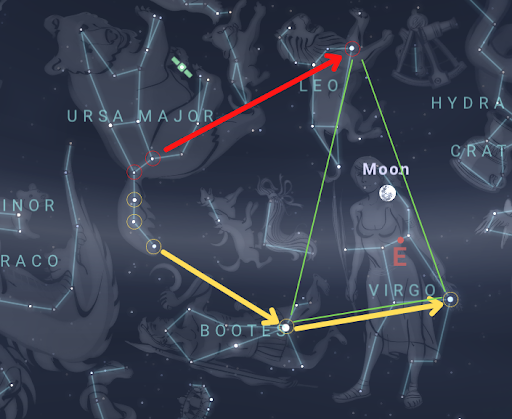
We can locate the Spring Triangle using the more conspicuous asterism of the Big Dipper. We can spot this star by drawing an imaginary line from Megrez (δ Ursae Majoris) to Phecda (γ Ursae Majoris) of the Big Dipper. Extending this line will point to Regulus.
The handle of the Big Dipper will point us to the other stars of the Spring Triangle. The handle of the Big Dipper is made up of Alkaid (η Ursae Majoris), Mizar (ζ Ursae Majoris), and Alioth (ε Ursae Majoris). This handle will lead to Arcturus in Boötes constellation, then to Spica in Virgo.
When to See the Spring Triangle
The Spring Triangle is called so because it is most prominent as the springtime approaches in the northern hemisphere, from around March to May.
Among its vertices, the star Regulus rises before the others. It is then followed by the red giant Arcturus, and eventually, Spica.
In March, these stars will have already climbed up the horizon before midnight. The best time to see it is in early April when the triangle can be easily seen in its entirety just between sundown and before midnight.
The Spring Triangle is just one of the seasonal star patterns of the northern sky. Other exciting asterisms to watch out for are the Summer Triangle, Winter Triangle, and the Winter Hexagon (or Winter Circle).
Though it is called the Spring Triangle, the name only applies to stargazers in the northern hemisphere. This is because while it is spring up north, it is autumn in the southern hemisphere. Also, this triangle will look upside down from the southern celestial hemisphere.
Stars of the Spring Triangle
Familiarizing ourselves with the stars of the Spring Triangle will help us identify this asterism better. Also, it is not hard to see it in the sky because its vertices are marked by first-magnitude stars.
Let us learn more about these stars.
Arcturus (α Boötis)
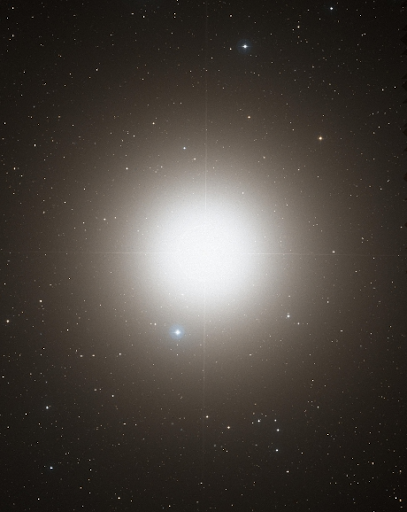
- Spectral type: K1.5 III Fe−0.5
- Apparent magnitude: -0.05
- Mass: 1.08 solar masses
- Radius: 25.4 solar radii
- Luminosity: 170 Suns
- Constellation: Boötes the Herdsman
- Distance: 36.7 light-years from the Sun
Arcturus is an orange giant star in the constellation Boötes. With an apparent magnitude of -0.05, it is the brightest star in the northern celestial hemisphere. Overall, it is the fourth brightest in our night sky.
The name Arcturus is from the Greek Arktouros which means “Guardian of the Bear.”
Arcturus is about as massive as the Sun but it is more than 20 times larger. At an age of 7.1 billion years, it is an aging star that has already evolved and expanded in size. It was thought to be located more at the center of its constellation in the past.
Now, this fast-moving star has moved off from the center of Boötes and is expected to be closest to the Sun around 4,000 years from now.
Arcturus is a single star that shines more than 100 times the luminosity of the Sun. The Fe−0.5 notation in its spectrum indicates that it is a bit underabundant in iron. It lies relatively close to us at 36.7 light-years distant.
Spica (α Virginis)
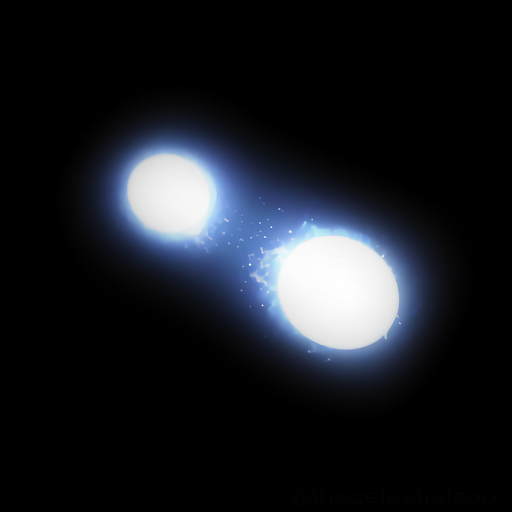
- Spectral type: B1V
- Apparent magnitude: 0.97
- Mass: 11.43 + 7.21 solar masses
- Radius: 7.47 + 3.74 solar radii
- Luminosity: 20,512 + 2,254 Suns
- Constellation: Virgo the Maiden
- Distance: 250 light-years from the Sun
Spica is a binary star system and the brightest point in the constellation of Virgo the Maiden. With a combined apparent magnitude of 0.97, it is among the 20 brightest stars in our night sky.
The star system is composed of two B-type stars that are so close to each other. As a spectroscopic binary, the component stars cannot be individually resolved. However, the spectrum was able to indicate its binary nature.
Spica is a rotating ellipsoidal variable. What this means is that the two stars in the system have become ellipsoidal or egg-shaped shape because of their close distance. They orbit each other in a four-day period.
The primary star in the system is a blue giant that is 11.43 times as massive as the Sun. Its companion has about 7 times the Sun’s mass.
Spica forms the Spring Triangle with Arcturus and Regulus. Among the three, Spica is the southernmost star in the asterism. It is located about 250 light-years from the solar system.
Regulus (α Leonis)
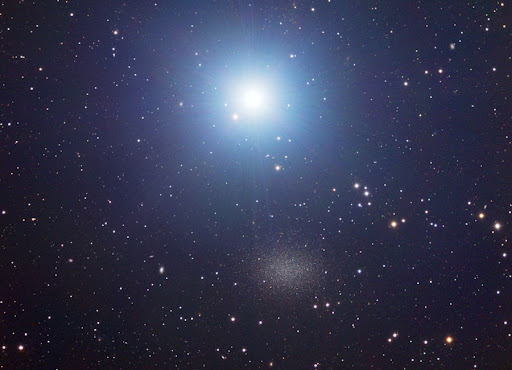
- Spectral type: B8 IVn
- Apparent magnitude: 1.40
- Mass: 3.8 solar masses
- Radius: 4.35 solar radii
- Luminosity: 316 Suns
- Constellation: Leo the Lion
- Distance: 79 light-years from the Sun
Regulus is a multiple star system with two pairs of stars—Regulus A and Regulus BC.
The primary pair, Regulus A, is composed of a subgiant star with the spectral type B8 IVn and a suspected white dwarf. The other pair, Regulus BC, is located 5,000 AU from Regulus A. This translates to 5,000 times the Sun-Earth distance.
Regulus A is almost 4 times as massive as the Sun. The fast rotation of this star has made it wider at the equator than its poles. In short, it became oblate or egg-like in shape. This resulted in gravity darkening, which means it is brighter in the poles than around the equator.
The name Regulus means “prince” or “little king” in Latin. It is the brightest point in the constellation Leo. It forms an asterism within this constellation called “the Sickle.” It is also part of the Spring Triangle and is the least bright vertex of the said asterism. This quadruple star system lies nearly 80 light-years from us.
Denebola (β Leonis)
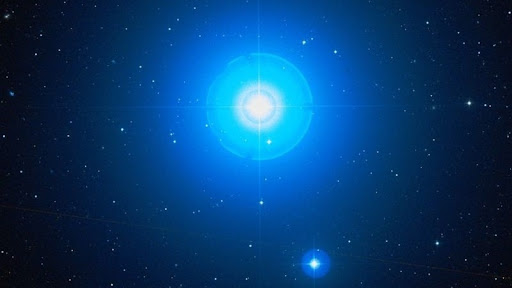
- Spectral type: A3Va
- Apparent magnitude: 2.113
- Mass: 1.78 solar masses
- Radius: 1.728 solar radii
- Luminosity: 15 Suns
- Constellation: Leo the Lion
- Distance: 35.9 light-years from the Sun
Denebola is second to Regulus as the brightest star in the Leo constellation. It is a white-hued star that is visible to the naked eye. This A-type star marks the tail of Leo the Lion. Its Arabic name, Deneb Alased, reflected this as it translates to “tail of the lion.”
Though Denebola is only about 400 million years old, it is nearly twice as massive as the Sun. It is also more luminous by 15 times. Since it is a fast-spinning star, it has a prominent equatorial bulge like Regulus.
In other sources, Denebola is sometimes the third point in the Spring Triangle asterism instead of Regulus. It lies 36 light-years from Earth.
The Great Diamond Asterism
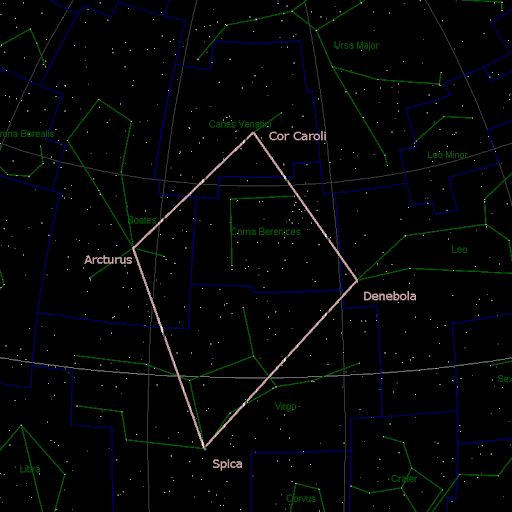
The Great Diamond is an asterism made up of some of the brightest stars in the spring night sky. It is like an extension of the smaller Spring Triangle asterism.
Below are the stars that make up this sky pattern:
| Stars in the Great Diamond | Constellations |
|---|---|
| Cor Caroli | Canes Venatici |
| Denebola | Leo |
| Spica | Virgo |
| Arcturus | Boötes |
Features of the Spring Triangle
The Spring Triangle lies in the region of Boötes, Virgo, and Leo. Each constellation is just as interesting as the stars that mark the three points of this asterism.
Boötes Constellation
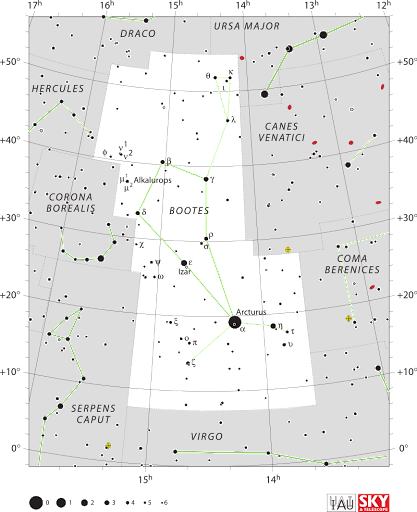
Boötes is located in the northern celestial hemisphere. In terms of area, it is the 13th largest among the 88 modern constellations. The name of this constellation has a Greek origin which means “herdsman” or “plowman.”
Aside from Arcturus, the constellation also has other famous stars like Izar. Star clusters are not abundant in Boötes but it has many galaxies over the region. Around 10 of its stars have planetary systems, and the famous Quadrantids shower originates from this constellation.
Different mythological stories are related to Boötes. One of which is that he was Philomelus, the son of Demeter. His brother Plutus, however, did not share his riches. Philomelus bought two oxen and invented the wagon to help him work on the fields.
Demeter admired Philomelus for what he did so she placed him in the sky as the Boötes constellation.
Virgo Constellation
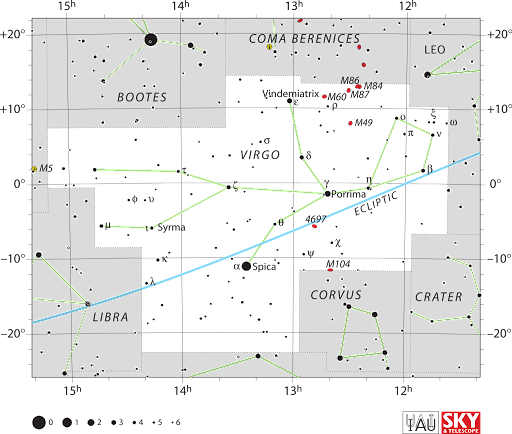
Virgo means “maiden” in Latin. It is the largest of the zodiac constellations. Also, with an area of 1,294 square degrees, it is the 2nd largest constellation overall after Hydra the Female Water Snake.
The constellation of Virgo boasts many deep-sky objects. The Virgo Cluster of galaxies lies in this region. The most famous galaxy in this cluster is the supergiant elliptical galaxy called Messier 87.
In 2019, M87 went down in history as the site of the first direct black hole image. This is the most massive black hole near the Milky Way, estimated to be around 7.2 billion times the Sun’s mass.
Virgo is associated with Demeter and Ceres in early Greek and Roman mythology.
Leo Constellation
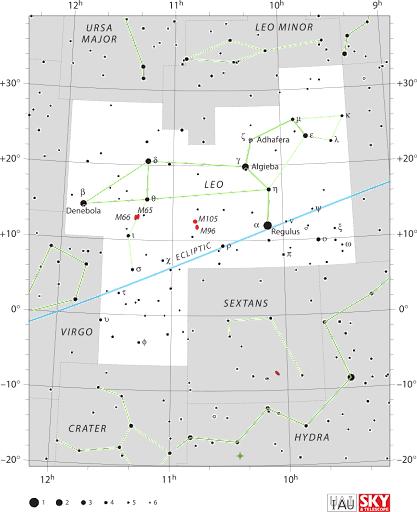
Leo is one of the most recognized constellations of the night sky. It has been recognized since ancient times, and the stars that form its pattern are easily visible to the naked eye. It is a zodiac constellation and the 12th largest in terms of area.
Another thing that makes it easier to spot is the “sickle” asterism. It looks like a backward question mark that depicts the lion’s mane and shoulders. The Leonids meteor shower originates from the Leo constellation.
Leo is associated with the Nemean Lion in Greek mythology. It is the lion that Heracles killed in one of his twelve labors.
Deep-Sky Objects in Spring Triangle
The Spring Triangle is a field of interesting galaxies and other deep-sky objects. Below are some of them:
Virgo Cluster
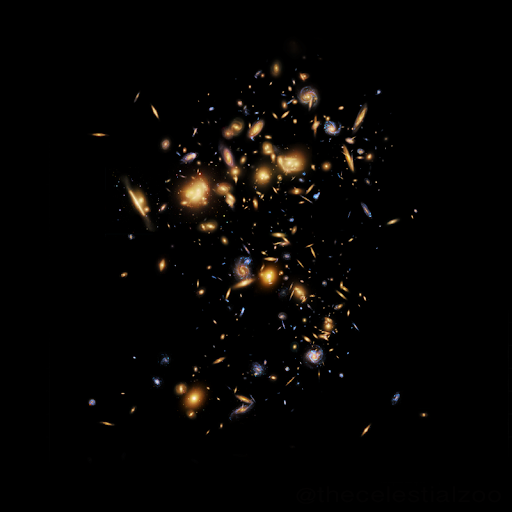
The Virgo Cluster is located in the constellation of the celestial maiden. More than 1,300 galaxies belong in this cluster. The members of this cluster are a mix of spiral and elliptical galaxies, with the brightest one being Messier 49.
Messier 87 (Virgo A)
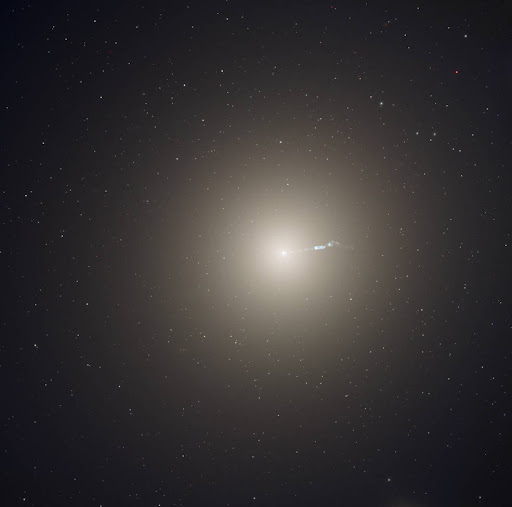
Messier 87 is the most notable member of the Virgo Cluster. It is a supergiant elliptical galaxy that is home to trillions of stars and around 15,000 globular clusters.
M87 was discovered by Charles Messier in 1781. We cannot see it with the unaided eye but a small telescope will reveal this deep-sky object. The best time to spot it is in May.
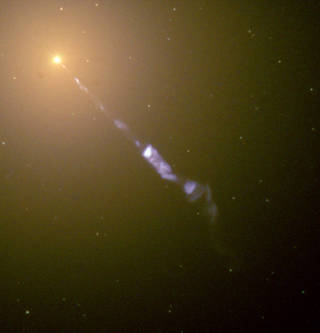
The most striking feature of the M87 is the blue jet that spurts from the center of the galaxy. This jet is powered by an active supermassive black hole. An image of this black hole was released in 2019, marking the first-ever image of a black hole ever taken.
The monstrous M87 galaxy is located 54 million light-years away from us.
M96 Group (Leo I Group)
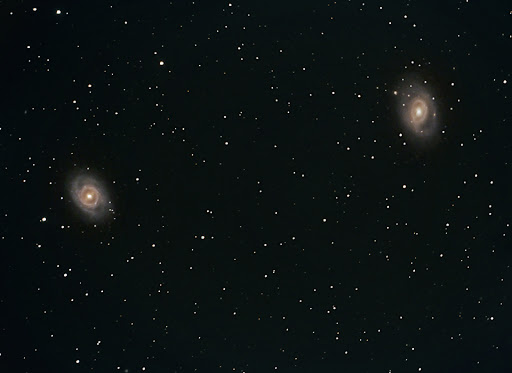
The M96 is a group of 8 to 24 galaxies. It belongs in the larger Virgo Supercluster. Some of its notable members are the barred spiral Messier 95, the intermediate spiral Messier 96, the elliptical galaxy Messier 105, and the intergalactic cloud called the Leo Ring.
Leo Triplet
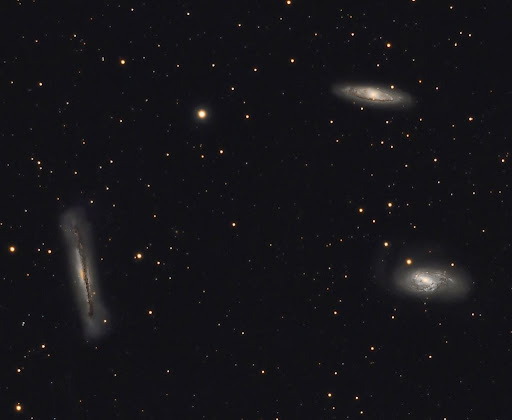
The Leo Triplet, also called the M66 Group, is composed of three spiral galaxies NGC 3628, M65, and M66. This trio is located 35 million light-years from the solar system.
NGC 3628 is a spiral galaxy without a bar at the center. Though, some experts argue that it may be a barred galaxy. A band of dust lies along its spiral arms. It is also called the Hamburger Galaxy.
M65 is an intermediate spiral with a low rate of star formation. Observations suggest that there is a disturbance in the galaxy causing its disk to become a little warped.
M66 is another spiral with a weak bar at the center. Estimates shows that it is around 95 thousand light-years in diameter. Since it is only separated 20′ from M65, these two make a good target for deep-sky observers.
Butterfly Galaxies (Siamese Twins)
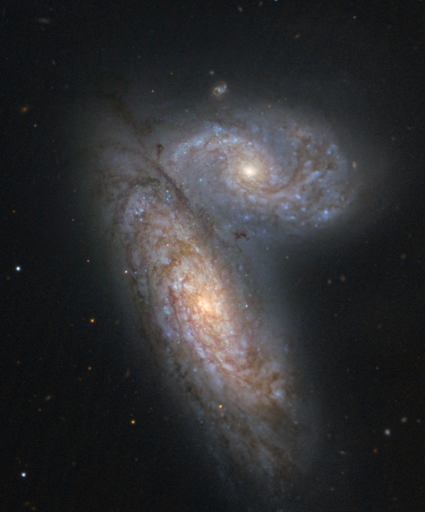
The Butterfly Galaxies are a pair of the interacting galaxies NGC 4567 and NGC 4568. These unbarred spiral galaxies are heading into a collision, and will eventually merge into one bigger galaxy.
This pair is located about 60 million light-years from us.
Eyes Galaxies
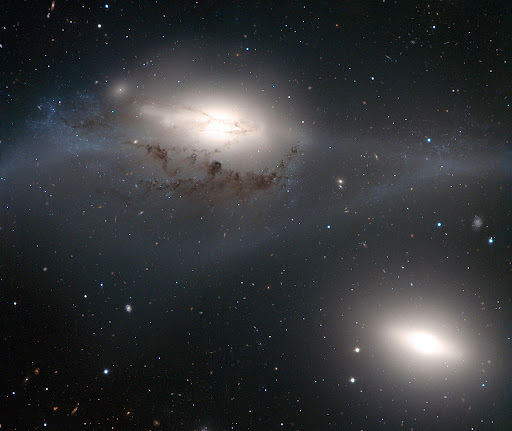
The Eyes Galaxies consist of NGC 4435 and NGC 4438. These are interacting galaxies that look like two eyes as seen on Earth. A starburst was observed in the nucleus of NGC 4435 as a result of this interaction. They are located 52 million light-years from us in the Virgo constellation.
Sources:
https://www.constellation-guide.com/spring-triangle/
https://www.space.com/3909-spring-triangle.html
https://en.wikipedia.org/wiki/Spring_Triangle
(https://earthsky.org/favorite-star-patterns/spring-triangle-regulus-arcturus-spica/)
https://www.nasa.gov/feature/goddard/2017/messier-87/
Image Sources:
The Spring Triangle Asterism: https://upload.wikimedia.org/wikipedia/commons/thumb/b/b4/Spring_Triangle_%28Stellarium%29.png/600px-Spring_Triangle_%28Stellarium%29.png
2 versions of the Spring Triangle: https://earthsky.org/upl/2019/02/new-spring_tri_2_SL-1.png
How to Find the Spring Triangle: https://stellarium-web.org/
Arcturus (α Boötis): https://upload.wikimedia.org/wikipedia/commons/5/5a/Arcturus_%28optical%29.png
Spica (α Virginis): https://upload.wikimedia.org/wikipedia/commons/thumb/2/2c/Alpha_Virginis.png/800px-Alpha_Virginis.png
Regulus (α Leonis): https://apod.nasa.gov/apod/image/1201/leoregulus_cook_900.jpg
Denebola (β Leonis): https://nineplanets.org/wp-content/uploads/2020/02/denebola-5725.jpg
The Great Diamond Asterism: https://upload.wikimedia.org/wikipedia/commons/2/24/Great_Diamond_map.gif
Boötes Constellation: https://upload.wikimedia.org/wikipedia/commons/thumb/4/47/Bo%C3%B6tes_IAU.svg/800px-Bo%C3%B6tes_IAU.svg.png
Virgo Constellation: https://upload.wikimedia.org/wikipedia/commons/thumb/f/f5/Virgo_IAU.svg/1024px-Virgo_IAU.svg.png
Leo Constellation: https://upload.wikimedia.org/wikipedia/commons/thumb/5/56/Leo_IAU.svg/800px-Leo_IAU.svg.png
Virgo Cluster: https://upload.wikimedia.org/wikipedia/commons/thumb/d/d2/Virgo_cluster.png/800px-Virgo_cluster.png
Messier 87 (Virgo A): https://www.nasa.gov/sites/default/files/styles/full_width/public/thumbnails/image/m87-full_jpg.jpg?itok=XqvbUq_t
M87 jet: https://www.nasa.gov/sites/default/files/styles/side_image/public/thumbnails/image/m87-jet.jpg?itok=goY-9JqO
M96 Group (Leo I Group): https://upload.wikimedia.org/wikipedia/commons/a/a1/AnttlersM95-m96.jpg
Leo Triplet: https://upload.wikimedia.org/wikipedia/commons/thumb/c/c7/LeoTripletHunterWilson.jpg/1024px-LeoTripletHunterWilson.jpg
Butterfly Galaxies (Siamese Twins): https://upload.wikimedia.org/wikipedia/commons/thumb/4/41/NGC_4567_%26_4568.png/800px-NGC_4567_%26_4568.png
Eyes Galaxies: https://upload.wikimedia.org/wikipedia/commons/thumb/7/76/NGC4438-NGC4435-eso1131a.jpg/1024px-NGC4438-NGC4435-eso1131a.jpg